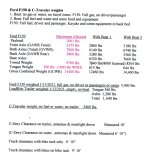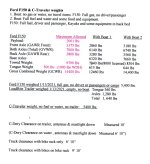colbysmith
Active member
- Joined
- Oct 2, 2011
- Messages
- 5,038
- Reaction score
- 15
- C Dory Year
- 2009
- C Dory Model
- 25 Cruiser
- Hull Identification Number
- UWH25301J809
- Vessel Name
- C-Traveler
thataway":25qwikzg said:I am not sure what point Colby is making--but the broken pole tongue trailer was never associated with a weight distribution hitch. That broke because of the multiple, bumps in I 10--which I have driven cross country multiple times. The same route long before interstates was also used even in the 1950's.
The last photo he shows is the replacement for the failed single axle trailer. Note that it is a dual axle trailer, which are recommended for the 22's if doing road trips.
Schuster":wp9bn2rj said:Bob I can relate to how this may have happened on I-10. I towed a 21' Atlas Pompano from Ram Rod Key Florida to Washington state. I had arranged to Tom at Atlas Boat Works to purchase a tandem axle trailer and have fitted to accept the 21' and he arranged that for me. We loaded the empty (no gear inside) boat and everything was fitted correctly with good tongue weight measured at the scales. Driving across Lake Pontchartrain bridge was quite the experience. The segments of concrete to make the road were spaced just right so at speed(55-60) you'd go over high spot causing the bow of the boat to want to raise up while the truck was going into the low area causing the bow to want to slam back down. The happened in succession one right after another with no rest between and no way to avoid being there with the traffic what it was. I feel very fortunate that I didn't have the exact same thing happen to me. What a ride.
Lessons learned from this episode..... make sure you are in the outside lane of the highway to be able to slow down without major traffic disruption.
In response to Donalds original question, hauling a trailer empty is definitely annoying but doable for sure. I've hauled a car hauler trailer empty from Washington to South Dakota and it bounced around back there for sure. Set the brake controlled down in intensity so the trailer tires aren't locking up, secure any loose/moveable items to reduce affects of vibration from road wear and you're good to go. It would be helpful to have some weight back there but it may not be worth the effort to rig up something to safely carry the weight (ie sand bags strapped to the running boards or something similar). Again safety first.
2009–2014 Ford F-150: The maximum towing capacity is 11,300 lbs.
2018 Ford F-150 Towing Capacities | LetsTowThat.com
The maximum towing capacity can vary based on the cargo, vehicle configuration, accessories, and number of passengers. The vehicle's doorjamb label will have the carrying capacity for a specific vehicle.
When towing with a Ford F-150, it's important to follow these guidelines: When towing with a Ford F-150, it's important to follow these guidelines:
Do not exceed the trailer weight of 5,000 lbs when towing without a weight-distribution system.
The combined weight of the vehicle and trailer cannot exceed the listed GCWR.
Notes: • Do not exceed trailer weight of 5,000 lbs. when towing without a weight-distribution system.
• Combined weight of vehicle and trailer cannot exceed listed GCWR.
• Do not exceed the Maximum Loaded Trailer Weight listed.
• Trailer tongue load weight should be 10% of total loaded trailer weight. Make sure vehicle payload (reduce by option
weight) will accommodate trailer tongue load weight and weight of passengers and cargo added to towing
vehicle. Addition of trailer tongue load weight and weight of passengers and cargo cannot cause vehicle weights to exceed
rear GAWR or GVWR. These ratings can be found on the vehicle Safety Compliance Certification Label.
• Calculated with SAE J2807® method.


WCF":1aqvysrh said:Colby - I have often wondered what trim level your F-150 is? Is it an XL? Do you have the long bed/wheelbase (I think called "standard bed") or short bed?
colbysmith":2s08vpib said:I believe it is the XL. Pretty basic.
DayBreak":ymdxyduh said:I was reading that the payload capacity of a 2025 F-150 can handle up to 3,325 pounds. With such a huge payload capacity on a new special ordered F-150 using this option, I would think that the truck would in no way need a weight distribution hitch towing a 25 Cruiser or 26 Venture. The rear end of this truck should easily handle this load directly placed on the ball (no WDH) of a truck like this with the factory tow package. Am I correct in my thinking here for safely towing a CD25 or CD26 uning this F-150 truck?
P.S. the truck I am referring to also has a tow rating in the area of about 13,000 lbs. Thanks. Gary
[/quote]Donald Tyson":1f3v7ou5 said:love to share some photos and details but I can’t even find my album anymore. People would get sooooo much more out of the site if we could Drag and drop like other sites. Shame.
I also use my F150 as my daily driver. After test driving a F250, and finding it handled like a truck....that is big to park in lots, and rough riding, I found the F150 to be quite a bit nicer riding. Also while still not a small car, a little easier to take into parking lots. As I've stated earlier, it does a fine job towing the 25, with or without full water and fuel it's tanks. But I don't tow over 75mph, and rarely go over 65mph. I have an aftermarket suspension system to help on the back end, and with electric brakes on the trailer (EOH) have full control of my trailer braking. The boat is balanced well with 8% of the load on the trailer hitch. When crosswinds start getting above 20-30mph, I tend to slow down a little more, to 55 or 60mph. I don't feel that the F150 is over it's capacity at all. I also use to drive semis where the tractor weighed around 20,000 lbs and the trailer around 60,000. So arguments against the weight ratio of the boat weighing more than the pickup don't hold much water with me. Colby
DayBreak":2tqe3dz6 said:I was reading that the payload capacity of a 2025 F-150 can handle up to 3,325 pounds. With such a huge payload capacity on a new special ordered F-150 using this option,
